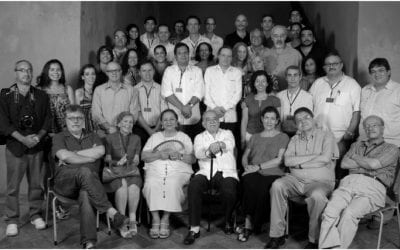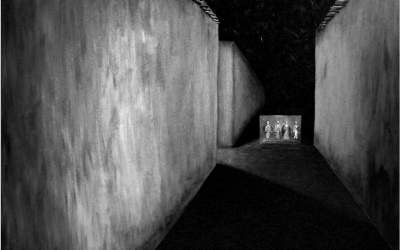Securing the City: Neoliberalism, Space, and Insecurity in Postwar Guatemala
An Urban Focus
Spring/Summer 2011, Volume X, Number 2

Securing the City: Neoliberalism, Space, and Insecurity in Postwar Guatemala Edited by Kevin Lewis O’Neill and Kedron Thomas Duke University Press 2011, 240 pages
Guatemala City is a difficult place to live, much less to love. Smoke-belching buses clog its arteries, lurching past shantytown-lined ravines, down once-grand boulevards, and through the hardscrabble neighborhoods of the working poor, against which the glitz of the Zona Viva stands in cruel counterpoint. Commuters rush home at dark to avoid becoming statistics: the homicide rate, at 109 per 100,000, is one of the highest in the world. One edition of the travel guide Lonely Planet bluntly includes, among its top five highlights of Guatemala City, “leaving.”
It’s not only tourists who’ve fled the city but academic researchers too, who often prefer to base themselves in the highlands where the breathtaking volcano views come smog-free. As the editors of Securing the City: Neoliberalism, Space, and Insecurity in Postwar Guatemala point out, most scholarship on Guatemala has focused on the rural life of the Maya, neglecting the capital city and its rich history. In this new volume, editors Kevin Lewis O’Neill and Kedron Thomas attempt the worthy task of addressing this gap.
Taking a page from New Left theorist Raymond Williams, the contributors to Securing the Cityunpack varied spatial imaginaries of both urban and rural Guatemala in order to dissect the crises provoked by the country’s neoliberal turn. The volume’s finest essays—those by Deborah Levenson, Manuela Camus, Rodrigo Véliz and coeditor O’Neill—illuminate the corrosive effects that the growing polarization of wealth, the deterioration of family and communal ties, and the privatization of public space have had on a country still reeling from decades of bloody state repression. Finally, the editors argue that, far from being discrete spheres, urban and rural Guatemala are inextricably linked—by commerce, by culture, and above all, by failed post-war expectations.
“Living the peace,” one essay suggests, “has proven elusive.” To find out why, Securing the City’s contributors examine what they call the “practices of neoliberalism.” Through this series of snapshots—of the informal economy, of the private security industry, of urban gentrification, of rising neo-Pentecostalism, of generational change, and, above all, of the precariousness of everyday life in Guate—O’Neill and Thomas themselves attempt to “secure the city,” to comprehend and theorize it. They emphasize that a new neoliberal order is to blame for the capital’s ills and extremes, an order in which “a new set of practices and strategies…privatize what would otherwise be the state’s responsibility” for guaranteeing Guatemalans’ health and welfare. As the essays show us, citizens have improvised a wide array of coping strategies—informal-economy entrepreneurship, migrating for security guard jobs and more.
It’s hard to dispute that structural adjustment policies and the opening of markets to a rather cynical interpretation of “freedom” have wrought devastation not just in Guatemala but across the Americas. Nonetheless, parts of Securing the City feel thin; the book’s focus on the practices of post-war neoliberalism leads it to largely neglect a serious analysis of the hobbled Guatemalan state or its pre- and post-1996 continuities. For example, the editors define neoliberal practices as “the broad-scale transference of state functions to private citizens” with particular emphasis on the privatization of security in the post-war period. Yet private security forces, some run directly out of the offices of the National Police, existed even during the worst of the war years, to say nothing of the paradigmatic example of security outsourcing—the mass conscription of hundreds of thousands of Maya villagers to serve in Civil Self-Defense Patrols (PACs). Speaking of the police, they win only the scantest of passing mentions in this book. How can we understand the privatization of postwar security without looking seriously at civil policing and at the thus-far failed attempts at police reform?
And while the editors critique the fact that the neoliberal state cannot keep its citizens safe, counterinsurgency survivors will recall that the pre-neoliberal state didn’t do a particularly good job of protecting Guatemalans either. In fact, the Guatemalan state has long been kept weak by design, undermined by tight-fisted oligarchy and, more recently, by parallel powers linked to military and narcotrafficking interests. If this neoliberal polyarchy fails to keep a social contract with the Guatemalan people, it is because the democratic transition of the mid-1980s was engineered by the military as a counterinsurgency strategy—it was designed to save face before an international chorus of lenders and human rights critics, not to save Guatemalans. It is no historical accident that the state’s civilian institutions are as weak, underfunded, and vulnerable to infiltration by organized crime as they are. And because the state has betrayed the vast majority of its population over and over again throughout the past two centuries, it is little wonder that citizens turn to ad-hoc, “privatized” survival strategies in order to carve out some semblance of functional lives.
The editors of Securing the City are to be applauded for working to shatter common narratives that pin the blame for Guatemala’s urban violence on “delinquents,” urban gangs, rural lynch mobs, or other such bogeymen. The work also dismantles the imagined boundaries between city and country, and for this it merits praise. It would be a stronger book if it included contributions on some of the most integral features of the post-conflict landscape: narcotrafficking and parallel powers; the challenges of postwar policing; the proliferation of foreign-funded NGOs; or perhaps the adoption industry, that controversial commodity chain connecting not only country to city, but city to world.
That said, one book cannot be expected to stand in for an entire field of inquiry; other writers must rise to the city’s formidable challenge. Guatemala City’s is a “beauty of witches,” as Paul Theroux writes, and despite the capital’s violence and inequality it remains a vital, fascinating locus of Central American life past and present. “The city is not dead,” as Levenson notes in her contribution to Securing the City, and though its epitaph has been written many times over, it is the responsibility of scholars, activists, and policymakers alike to refrain from consigning it to a premature death.
Kirsten Weld is the Florence Levy Kay Fellow in Latin American History at Brandeis University. She is currently completing a book manuscript on the 2005 discovery of Guatemala’s National Police Archives.
Related Articles
New Journalists for a New World
I received a surprising phone call one day in late 1993, when I was the director of Telecaribe, a public television channel in Barranquilla, Colombia. The caller was none other than Gabriel García Márquez. “Will you invite me to dinner?” he asked me. “Of course, Gabito,” I…
Latin American Nieman Fellows
A few days after I arrived at Harvard in August 2000 to begin my work as curator of the Nieman Foundation for Journalism, Tim Golden, an investigative reporter for the New York Times in Latin America, phoned me. “Could I find a place in the new Nieman class for a Colombian…
Freedom of Expression in Latin America
In June 1997, Chile’s Supreme Court upheld a ban on the film “The Last Temptation of Christ,” based on a Pinochet-era provision of the country’s constitution. Four years later, the Inter-American Court of Human Rights heard a challenge to this ban and issued a very different…




